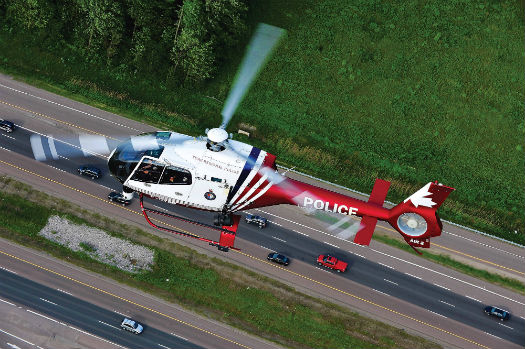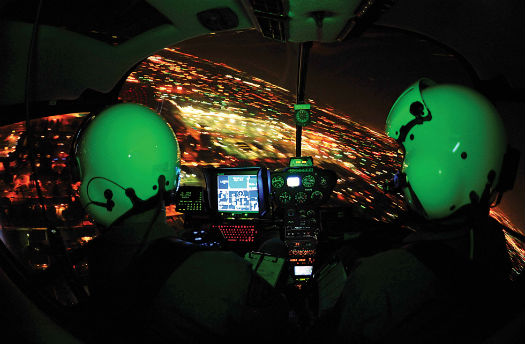
Properly managing a vehicle pursuit isn’t about being “Big Brother” in the sky, it’s about working to keep the officers and public safe below. Skip Robinson Photo
Having a trained aircrew over a vehicle pursuit has obvious value in the apprehension of the suspect, but in a world of liability and second-guessing, we must strive to maximize what we do and how we do it to keep the public and our officers safe. This isn’t always easy when we focus much of our effort on “the capture” of the suspect. While I’m all about handcuffs on bad guys, let’s broaden our view a little when managing pursuits from above.
As a tactical flight officer, what is your role over the pursuit? Is it just “painting the picture” and calling out streets? Or are you truly managing the pursuit? An agency that is fortunate enough to have an air asset available has a tool that should increase the possibility of safely capturing the suspect, while decreasing the risk to the pursuing officers. To do both effectively is a fine balancing act, and takes great management and skill.
The first thing to remember when arriving over a vehicle pursuit is that the officers involved are at a high stress level, which can cause even the most seasoned officer to have tunnel vision. As the tactical flight officer, you have the ability to reduce that stress in many ways — starting with a calm, cool, confident voice on the radio. That may be easier said than done, but the best tactical flight officers work hard at this, and the results they get are outstanding. No matter what is happening on the ground, they are always calm and seem in complete control. This makes a big difference to the officer behind the wheel in how they drive, their decision-making, and in their situational awareness.
If you are able to broadcast the pursuit in order to relieve the officer on the ground of that duty, you should do so. Driving and keying a radio is a bad combination in a high-speed pursuit. Make sure that you are providing good situational observations for the officer as well; look ahead for traffic conditions, construction zones, dead end streets, T intersections, and any other hazard that could cause problems. These simple observations can make the difference between a safe apprehension and disaster. If you are working a camera or forward looking infrared over a pursuit, be sure to widen the view regularly, and, most importantly, get your pilot involved in looking out ahead of the pursuit. A good crew communicating and working together mitigates a lot of risk.
During a pursuit, we must always think about taking care of our brothers and sisters on the ground in everything we say and do. You will see and hear officers getting very excited and “over driving” when they become purely focused on the capture. Never be afraid to key the microphone to calmly tell an officer to slow down. Let them know that you have the car, and the suspect is not getting away. Many departments have this built into their pursuit policy. Some call it “surveillance mode” or “tracking” — but it doesn’t matter what it’s called, as long as the officers know they can back off and slow down because you now have the vehicle in sight and can manage the pursuit. I have attended meetings about pursuits where the so-called department vehicle pursuit expert has claimed that when officers back off, the suspect will immediately slow down and even stop. That’s not the case in my experience, but allowing officers to slow down enhances their safety, so it is a good practice to add to your pursuit policy.
Managing a pursuit this way isn’t about being “Big Brother” in the sky; it’s purely about looking after each other and just working to the best of your ability to doing to keep the officers and the public safe. In aviation, we talk all the time about risk analysis, mitigating risk, acceptable risk, and managing risks — that is exactly what you are doing over a pursuit, and you should think about pursuits in those terms. We can’t eliminate risk, but we can manage it.

The key to a successful vehicle pursuit is balance — keeping those in pursuit close enough so that they’re quickly on-scene after a suspect bails out, but not so close as to endanger safety. Mike Reyno Photo
Finding the right balance
So what happens if we don’t manage pursuits properly? Officers and members of the public get hurt, and pursuit policies get very restrictive. Eliminating pursuits altogether, as many departments have done, just announces to every career criminal to run. I understand why department commands do this — it is an easy “fix” to the problem of liability. The fact that crime will increase because fewer criminals are going to jail becomes secondary. However, some commands are starting to think outside the box, and it’s refreshing to see. Air assets can be a big part of the solution, as long as we are proactive, forward thinking, and put the safety of our officers first.
Attending roll calls, training days, or just meeting officers at a coffee spot can go a long way in conveying this concept. If officers know that your decisions and management of a pursuit truly has their safety at heart, most will accept it. Explain to them that the chance of the suspect escaping after you are over the pursuit is extremely low, so they can slow down and concentrate on driving. It really is a simple concept, but I would be the first to say that it isn’t always easy to do. You WILL get push back from some officers.
During a pursuit, the key is finding a balance — you will need those officers when the suspect or suspects bail out of that vehicle. Even the most skilled aircrews have lost suspects after a bail out when ground units have taken a long time to arrive at the scene. I wish there was an easy formula for managing the proximity of ground units during a pursuit, but there isn’t; you have to look at each situation and tactically evaluate it — while at the same time managing the risk to the pursuing officers.
One of the most frustrating pursuits I was involved in ended with the suspect getting away. It was a long pursuit that involved multiple agencies terminating the pursuit and handing off to the next agency. That alone caused enough issues to fill an article, but the last agency to take the pursuit was mine. The officers were close to the suspect, the speeds were manageable, and, as it was 4 a.m., there was no traffic in the area. A supervisor quickly told the officers to terminate the pursuit, despite our objections. The officers dutifully followed the directions, and now it was just us over the vehicle. The suspect did not slow down at all.
He eventually bailed out of the vehicle and immediately used buildings on the backside of our orbit to avoid detection. We requested a perimeter containment, but the ground units were so far away at this point that it took almost 10 minutes for the first of many to arrive. By that time, the suspect could have been in the next county — and maybe he was. We knew the perimeter was a waste of time, and called it off. The point I’m making here is you still need ground units reasonably close in order to contain a suspect. Balancing that distance is part of managing the pursuit. That management was taken away from us that morning, and the bad guy beat us.
So let’s finish this discussion with some apprehension tactics for when the pursuit terminates and the suspect is running. If your ground officers are not right on top of the bail out when you lose sight of the suspect, consider a perimeter containment. The size of the containment should be based on the kind of area you are over (urban, rural, or wooded), what the suspect is wanted for, and how soon units will be available to contain the path of the suspect. Again, there’s no easy solution; you need to make good tactical decisions as quickly as possible based on the totality of the circumstances.
Managing a pursuit is a very complicated issue with lots of layers. It’s difficult to balance the need to uphold the law with public safety, officer safety, and liability, but having air assets over a pursuit provides options. And the ability to do all those things at once is where we, in airborne law enforcement, should shine. We have a unique perspective flying over pursuits and we need to be as effective as possible in sharing that perspective. I hope this discussion stimulates some conversation outside the norm so we can keep our officers safe. It is always a good thing to widen our view from time to time.





